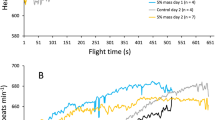Pelicans flying in a 'V' can glide for extended periods using the other birds' air streams.
Abstract
Many species of large bird fly together in formation, perhaps because flight power demands and energy expenditure can be reduced when the birds fly at an optimal spacing1,2,3, or because orientation is improved by communication within groups4. We have measured heart rates as an estimate of energy expenditure in imprinted great white pelicans (Pelecanus onocrotalus) trained to fly in 'V' formation, and show that these birds save a significant amount of energy by flying in formation. This advantage is probably a principal reason for the evolution of flight formation in large birds that migrate in groups.


Similar content being viewed by others
References
Lissaman, P. B. S. & Shollenberg, C. A. Science 168, 1003–1005 (1970).
Badgerow, J. P. & Hainsworth, F. R. J. Theor. Biol. 93, 41–52 (1981).
Hummel, D. J. Theor. Biol. 104, 321–347 (1983).
Hamilton, W. J. in Animal Orientation and Navigation (ed. Storm, R. M.) 57–71 (Oregon State Univ. Press, Corvallis, 1967).
Weimerskirch, H. et al. Proc. R. Soc. Lond. B 267, 1869–1874 (2000).
Hainsworth, F. R. J. Exp. Biol. 135, 431–444 (1988).
Badgerow, J. P. Auk 105, 749–755 (1988).
Cutts, C. J. & Speakman, J. R. J. Exp. Biol. 189, 251–261 (1999).
Higdon, J. J. L. & Corrsin, S. Am. Nat. 112, 727–744 (1978).
O'Malley, J. B. E. & Evans, R. M. Can. J. Zool. 60, 1388–1396 (1982).
Gould, L. L. & Heppner, F. Auk 91, 494–506 (1974).
Author information
Authors and Affiliations
Corresponding author
Rights and permissions
About this article
Cite this article
Weimerskirch, H., Martin, J., Clerquin, Y. et al. Energy saving in flight formation. Nature 413, 697–698 (2001). https://doi.org/10.1038/35099670
Issue Date:
DOI: https://doi.org/10.1038/35099670
- Springer Nature Limited
This article is cited by
-
Bio-inspired design of next-generation ultrapermeable membrane systems
npj Clean Water (2024)
-
Flow development and leading edge vorticity in bristled insect wings
Journal of Comparative Physiology A (2023)
-
Autonomous Formation Flight Control of Large-Sized Flapping-Wing Flying Robots Based on Leader–Follower Strategy
Journal of Bionic Engineering (2023)
-
Vision and vocal communication guide three-dimensional spatial coordination of zebra finches during wind-tunnel flights
Nature Ecology & Evolution (2022)





